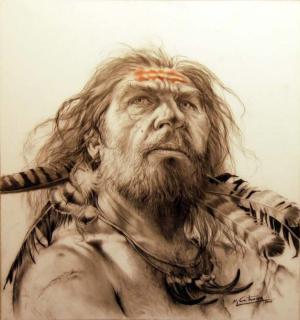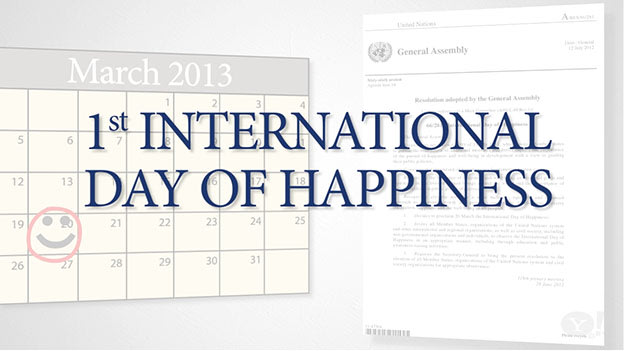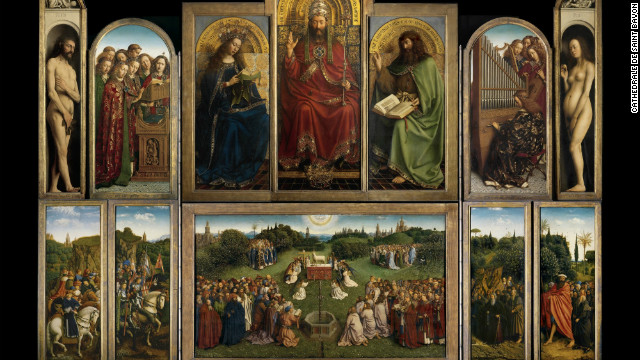Humans Broke Off Neanderthal Sex After Discovering Eurasia - Neanderthals apparently last interbred with the ancestors of today's Europeans after modern humans with advanced stone tools expanded out of Africa, researchers say.
The last sex between Neanderthals and modern humans likely occurred as recently as 47,000 years ago, the researchers added.
Modern humans once shared the globe with now-departed human lineages, including the Neanderthals, our closest known extinct relatives. Neanderthals had been around for about 30,000 years when modern humans appeared in the fossil record about 200,000 years ago. Neanderthals disappeared about 30,000 year ago.

In 2010, scientists completed the first sequence of the Neanderthal genome using DNA extracted from fossils, and an examination of the genetic material suggested that modern humans' ancestors occasionally successfully interbred with Neanderthals. Recent estimates reveal that Neanderthal DNA makes up 1 percent to 4 percent of modern Eurasian genomes, perhaps endowing some people with the robust immune systems they enjoy today.
The Neanderthal genome revealed that people outside Africa share more genetic variants with Neanderthals than Africans do. One possible explanation is that modern humans mixed with Neanderthals after the modern lineage began appearing outside Africa at least 100,000 years ago. Another, more complex scenario is that an African group ancestral to both Neanderthals and certain modern human populations genetically diverged from other Africans beginning about 230,000 years ago. This group then stayed genetically distinct until it eventually left Africa.
To shed light on why Neanderthals appear most closely related to people outside Africa, researchers looked at similar DNA chunks in European and Neanderthal genomes. When sperm and egg cells are created, the strands of DNA within them break and rejoin to form new combinations of genetic material. This "recombination" decreases the length of the chunks in each generation. By comparing lengths, "we can estimate when the two populations last shared genes," explained researcher Sriram Sankararaman, a statistical geneticist at Harvard Medical School.
The research team estimates modern humans and Neanderthals last exchanged genes between 37,000 and 86,000 years ago, and most likely 47,000 to 65,000 years ago. This is well after modern humans began expanding outside Africa, but potentially before they started spreading across Eurasia.
These findings suggest modern humans last shared ancestors with Neanderthals during the period known as the Upper Paleolithic. Back then, modern humans had begun using relatively advanced stone tools, such as knife blades, spear points, and engraving and drilling implements.
"I think we will be able to get new insights on how modern humans adapted as they occupied new regions," Sankararaman told LiveScience. "It shows the power of genetic data to learn about historical events."
Future research will explore other prehistoric interbreeding events, such as the apparent mixing between ancestors of modern Papuans and the recently unearthed extinct human lineage known as the Denisovans.
"There are technical challenges here," Sankararaman said. "Papuans have had gene flow from Neanderthals and from Denisovans. That makes it challenging to tease their contributions apart."
The scientists detailed their findings online Oct. 4 in the journal PLoS Genetics. ( LiveScience.com )
The last sex between Neanderthals and modern humans likely occurred as recently as 47,000 years ago, the researchers added.
Modern humans once shared the globe with now-departed human lineages, including the Neanderthals, our closest known extinct relatives. Neanderthals had been around for about 30,000 years when modern humans appeared in the fossil record about 200,000 years ago. Neanderthals disappeared about 30,000 year ago.

The last sex between Neanderthals and modern humans likely occurred as recently as 47,000 years ago, suggests research detailed online Oct. 4, 2012, in the journal PLoS Genetics
The Neanderthal genome revealed that people outside Africa share more genetic variants with Neanderthals than Africans do. One possible explanation is that modern humans mixed with Neanderthals after the modern lineage began appearing outside Africa at least 100,000 years ago. Another, more complex scenario is that an African group ancestral to both Neanderthals and certain modern human populations genetically diverged from other Africans beginning about 230,000 years ago. This group then stayed genetically distinct until it eventually left Africa.
To shed light on why Neanderthals appear most closely related to people outside Africa, researchers looked at similar DNA chunks in European and Neanderthal genomes. When sperm and egg cells are created, the strands of DNA within them break and rejoin to form new combinations of genetic material. This "recombination" decreases the length of the chunks in each generation. By comparing lengths, "we can estimate when the two populations last shared genes," explained researcher Sriram Sankararaman, a statistical geneticist at Harvard Medical School.
The research team estimates modern humans and Neanderthals last exchanged genes between 37,000 and 86,000 years ago, and most likely 47,000 to 65,000 years ago. This is well after modern humans began expanding outside Africa, but potentially before they started spreading across Eurasia.
These findings suggest modern humans last shared ancestors with Neanderthals during the period known as the Upper Paleolithic. Back then, modern humans had begun using relatively advanced stone tools, such as knife blades, spear points, and engraving and drilling implements.
"I think we will be able to get new insights on how modern humans adapted as they occupied new regions," Sankararaman told LiveScience. "It shows the power of genetic data to learn about historical events."
Future research will explore other prehistoric interbreeding events, such as the apparent mixing between ancestors of modern Papuans and the recently unearthed extinct human lineage known as the Denisovans.
"There are technical challenges here," Sankararaman said. "Papuans have had gene flow from Neanderthals and from Denisovans. That makes it challenging to tease their contributions apart."
The scientists detailed their findings online Oct. 4 in the journal PLoS Genetics. ( LiveScience.com )
READ MORE - Humans Broke Off Neanderthal Sex After Discovering Eurasia LiveScience.com




